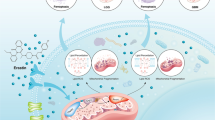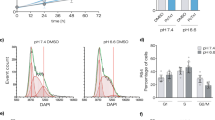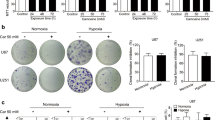Abstract
Extracellular acidosis (low pH) is a tumor microenvironmental stressor that has a critical function in the malignant progression and metastatic dissemination of tumors. To survive under stress conditions, tumor cells must evolve resistance to stress-induced toxicity. Acyl-CoA synthetase 5 (ACSL5) is a member of the ACS family, which converts fatty acid to acyl-CoA. ACSL5 is frequently overexpressed in malignant glioma, whereas its functional significance is still unknown. Using retrovirus-mediated stable gene transfer (gain of function) and small interfering RNA-mediated gene silencing (loss of function), we show here that ACSL5 selectively promotes human glioma cell survival under extracellular acidosis. ACSL5 enhanced cell survival through its ACS catalytic activity. To clarify the genome-wide changes in cell signaling pathways by ACSL5, we performed cDNA microarray analysis and identified an ACSL5-dependent gene expression signature. The analysis revealed that ACSL5 was critical to the expression of tumor-related factors including midkine (MDK), a heparin-binding growth factor frequently overexpressed in cancer. Knockdown of MDK expression significantly attenuated ACSL5-mediated survival under acidic state. These results indicate that ACSL5 is a critical factor for survival of glioma cells under acidic tumor microenvironment, thus providing novel molecular basis for cancer therapy.
This is a preview of subscription content, access via your institution
Access options
Subscribe to this journal
Receive 50 print issues and online access
$259.00 per year
only $5.18 per issue
Buy this article
- Purchase on Springer Link
- Instant access to full article PDF
Prices may be subject to local taxes which are calculated during checkout





Similar content being viewed by others
References
Bogazzi F, Hudson LD, Nikodem VM . (1994). A novel heterodimerization partner for thyroid hormone receptor. Peroxisome proliferator-activated receptor. J Biol Chem 269: 11683–11686.
Brusselmans K, De Schrijver E, Verhoeven G, Swinnen JV . (2005). RNA interference-mediated silencing of the acetyl-CoA-carboxylase-alpha gene induces growth inhibition and apoptosis of prostate cancer cells. Cancer Res 65: 6719–6725.
Cao Y, Dave KB, Doan TP, Prescott SM . (2001). Fatty acid CoA ligase 4 is up-regulated in colon adenocarcinoma. Cancer Res 61: 8429–8434.
Cao Y, Pearman AT, Zimmerman GA, McIntyre TM, Prescott SM . (2000). Intracellular unesterified arachidonic acid signals apoptosis. Proc Natl Acad Sci USA 97: 11280–11285.
Caviglia JM, Li LO, Wang S, DiRusso CC, Coleman RA, Lewin TM . (2004). Rat long chain acyl-CoA synthetase 5, but not 1, 2, 3, or 4, complements Escherichia coli fadD. J Biol Chem 279: 11163–11169.
Coe NR, Smith AJ, Frohnert BI, Watkins PA, Bernlohr DA . (1999). The fatty acid transport protein (FATP1) is a very long chain acyl-CoA synthetase. J Biol Chem 274: 36300–36304.
Coleman RA, Lewin TM, Van Horn CG, Gonzalez-Baro MR . (2002). Do long-chain acyl-CoA synthetases regulate fatty acid entry into synthetic versus degradative pathways? J Nutr 132: 2123–2126.
Gassler N, Herr I, Schneider A, Penzel R, Langbein L, Schirmacher P et al. (2005). Impaired expression of acyl-CoA synthetase 5 in sporadic colorectal adenocarcinomas. J Pathol 207: 295–300.
Graeber TG, Osmanian C, Jacks T, Housman DE, Koch CJ, Lowe SW et al. (1996). Hypoxia-mediated selection of cells with diminished apoptotic potential in solid tumours. Nature 379: 88–91.
Harris AL . (2002). Hypoxia––a key regulatory factor in tumour growth. Nat Rev Cancer 2: 38–47.
Hatzivassiliou G, Zhao F, Bauer DE, Andreadis C, Shaw AN, Dhanak D et al. (2005). ATP citrate lyase inhibition can suppress tumor cell growth. Cancer Cell 8: 311–321.
Ikematsu S, Yano A, Aridome K, Kikuchi M, Kumai H, Nagano H et al. (2000). Serum midkine levels are increased in patients with various types of carcinomas. Br J Cancer 83: 701–706.
Jia HL, Ye QH, Qin LX, Budhu A, Forgues M, Chen Y et al. (2007). Gene expression profiling reveals potential biomarkers of human hepatocellular carcinoma. Clin Cancer Res 13: 1133–1139.
Kadomatsu K, Hagihara M, Akhter S, Fan QW, Muramatsu H, Muramatsu T . (1997). Midkine induces the transformation of NIH3T3 cells. Br J Cancer 75: 354–359.
Kadomatsu K, Muramatsu T . (2004). Midkine and pleiotrophin in neural development and cancer. Cancer Lett 204: 1391–1399.
Kitanaka C, Kuchino Y . (1999). Caspase-independent programmed cell death with necrotic morphology. Cell Death Differ 6: 508–515.
Knudsen KE, Booth D, Naderi S, Sever-Chroneos Z, Fribourg AF, Hunton IC et al. (2000). RB-dependent S-phase response to DNA damage. Mol Cell Biol 20: 7751–7763.
Kuhajda FP . (2006). Fatty acid synthase and cancer: new application of an old pathway. Cancer Res 66: 5977–5980.
Lewin TM, Kim JH, Granger DA, Vance JE, Coleman RA . (2001). Acyl-CoA synthetase isoforms 1, 4, and 5 are present in different subcellular membranes in rat liver and can be inhibited independently. J Biol Chem 276: 24674–24679.
Liang YC, Wu CH, Chu JS, Wang CK, Hung LF, Wang YJ et al. (2005). Involvement of fatty acid-CoA ligase 4 in hepatocellular carcinoma growth: roles of cyclic AMP and p38 mitogen-activated protein kinase. World J Gastroenterol 11: 2557–2563.
Maeda S, Shinchi H, Kurahara H, Mataki Y, Noma H, Maemura K et al. (2007). Clinical significance of midkine expression in pancreatic head carcinoma. Br J Cancer 97: 405–411.
Mashek DG, McKenzie MA, Van Horn CG, Coleman RA . (2006). Rat long chain acyl-CoA synthetase 5 increases fatty acid uptake and partitioning to cellular triacylglycerol in McArdle-RH7777 cells. J Biol Chem 281: 945–950.
Mashima T, Oh-hara T, Sato S, Mochizuki M, Sugimoto Y, Yamazaki K et al. (2005). p53-defective tumors with a functional apoptosome-mediated pathway: a new therapeutic target. J Natl Cancer Inst 97: 765–777.
Mashima T, Tsuruo T . (2005). Defects of the apoptotic pathway as therapeutic target against cancer. Drug Resist Updat 8: 339–343.
Menendez JA, Lupu R . (2007). Fatty acid synthase and the lipogenic phenotype in cancer pathogenesis. Nat Rev Cancer 7: 763–777.
Mirkin BL, Clark S, Zheng X, Chu F, White BD, Greene M et al. (2005). Identification of midkine as a mediator for intercellular transfer of drug resistance. Oncogene 24: 4965–4974.
Mishima K, Asai A, Kadomatsu K, Ino Y, Nomura K, Narita Y et al. (1997). Increased expression of midkine during the progression of human astrocytomas. Neurosci Lett 233: 29–32.
Mishima K, Johns TG, Luwor RB, Scott AM, Stockert E, Jungbluth AA et al. (2001). Growth suppression of intracranial xenografted glioblastomas overexpressing mutant epidermal growth factor receptors by systemic administration of monoclonal antibody (mAb) 806, a novel monoclonal antibody directed to the receptor. Cancer Res 61: 5349–5354.
Nakagawara A, Milbrandt J, Muramatsu T, Deuel TF, Zhao H, Cnaan A et al. (1995). Differential expression of pleiotrophin and midkine in advanced neuroblastomas. Cancer Res 55: 1792–1797.
O’Brien T, Cranston D, Fuggle S, Bicknell R, Harris AL . (1996). The angiogenic factor midkine is expressed in bladder cancer, and overexpression correlates with a poor outcome in patients with invasive cancers. Cancer Res 56: 2515–2518.
Ohtsubo T, Wang X, Takahashi A, Ohnishi K, Saito H, Song CW et al. (1997). p53-dependent induction of WAF1 by a low-pH culture condition in human glioblastoma cells. Cancer Res 57: 3910–3913.
Reichert M, Steinbach JP, Supra P, Weller M . (2002). Modulation of growth and radiochemosensitivity of human malignant glioma cells by acidosis. Cancer 95: 1113–1119.
Rofstad EK, Mathiesen B, Kindem K, Galappathi K . (2006). Acidic extracellular pH promotes experimental metastasis of human melanoma cells in athymic nude mice. Cancer Res 66: 6699–6707.
Schoonjans K, Staels B, Auwerx J . (1996). Role of the peroxisome proliferator-activated receptor (PPAR) in mediating the effects of fibrates and fatty acids on gene expression. J Lipid Res 37: 907–925.
Seimiya H, Tanji M, Oh-hara T, Tomida A, Naasani I, Tsuruo T . (1999). Hypoxia up-regulates telomerase activity via mitogen-activated protein kinase signaling in human solid tumor cells. Biochem Biophys Res Commun 260: 365–370.
Soengas MS, Alarcon RM, Yoshida H, Giaccia AJ, Hakem R, Mak TW et al. (1999). Apaf-1 and caspase-9 in p53-dependent apoptosis and tumor inhibition. Science 284: 156–159.
Sung YK, Hwang SY, Park MK, Bae HI, Kim WH, Kim JC et al. (2003). Fatty acid-CoA ligase 4 is overexpressed in human hepatocellular carcinoma. Cancer Sci 94: 421–424.
Sung YK, Park MK, Hong SH, Hwang SY, Kwack MH, Kim JC et al. (2007). Regulation of cell growth by fatty acid-CoA ligase 4 in human hepatocellular carcinoma cells. Exp Mol Med 39: 477–482.
Takei Y, Kadomatsu K, Matsuo S, Itoh H, Nakazawa K, Kubota S et al. (2001). Antisense oligodeoxynucleotide targeted to Midkine, a heparin-binding growth factor, suppresses tumorigenicity of mouse rectal carcinoma cells. Cancer Res 61: 8486–8491.
Tannock IF, Rotin D . (1989). Acid pH in tumors and its potential for therapeutic exploitation. Cancer Res 49: 4373–4384.
Tao Q, Fujimoto J, Men T, Ye X, Deng J, Lacroix L et al. (2007). Identification of the retinoic acid-inducible Gprc5a as a new lung tumor suppressor gene. J Natl Cancer Inst 99: 1668–1682.
Tomida A, Tsuruo T . (1999). Drug resistance mediated by cellular stress response to the microenvironment of solid tumors. Anticancer Drug Des 14: 169–177.
Tong Y, Mentlein R, Buhl R, Hugo HH, Krause J, Mehdorn HM et al. (2007). Overexpression of midkine contributes to anti-apoptotic effects in human meningiomas. J Neurochem 100: 1097–1107.
Uehara K, Matsubara S, Kadomatsu K, Tsutsui J, Muramatsu T . (1992). Genomic structure of human midkine (MK), a retinoic acid-responsive growth/differentiation factor. J Biochem 111: 563–567.
van den Beucken T, Koritzinsky M, Wouters BG . (2006). Translational control of gene expression during hypoxia. Cancer Biol Ther 5: 749–755.
Vaupel P, Kallinowski F, Okunieff P . (1989). Blood flow, oxygen and nutrient supply, and metabolic microenvironment of human tumors: a review. Cancer Res 49: 6449–6465.
Xie S, Luca M, Huang S, Gutman M, Reich R, Johnson JP et al. (1997). Expression of MCAM/MUC18 by human melanoma cells leads to increased tumor growth and metastasis. Cancer Res 57: 2295–2303.
Yamashita Y, Kumabe T, Cho YY, Watanabe M, Kawagishi J, Yoshimoto T et al. (2000). Fatty acid induced glioma cell growth is mediated by the acyl-CoA synthetase 5 gene located on chromosome 10q25.1–q25.2, a region frequently deleted in malignant gliomas. Oncogene 19: 5919–5925.
Ye C, Qi M, Fan QW, Ito K, Akiyama S, Kasai Y et al. (1999). Expression of midkine in the early stage of carcinogenesis in human colorectal cancer. Br J Cancer 79: 179–184.
Yeh CS, Wang JY, Cheng TL, Juan CH, Wu CH, Lin SR . (2006). Fatty acid metabolism pathway play an important role in carcinogenesis of human colorectal cancers by microarray–bioinformatics analysis. Cancer Lett 233: 297–308.
Acknowledgements
We thank the National Cancer Institute as well as T Yamori for providing us SF268 and SNB78 cell lines and S Aaronson and K Mishima for A1207 cell lines. We thank A Tomida, S Saito and A Furuno for technical advice on GeneChip analysis, S Okabe for technical support, and T Migita and members in our laboratory for helpful discussions. This study was supported by a Grant-in-Aid for Cancer Research on Priority Areas and a Grant-in-Aid for Young Scientists from the Ministry of Education, Culture, Sports, Science and Technology, Japan.
Author information
Authors and Affiliations
Corresponding author
Additional information
Supplementary Information accompanies the paper on the Oncogene website (http://www.nature.com/onc)
Supplementary information
Rights and permissions
About this article
Cite this article
Mashima, T., Sato, S., Sugimoto, Y. et al. Promotion of glioma cell survival by acyl-CoA synthetase 5 under extracellular acidosis conditions. Oncogene 28, 9–19 (2009). https://doi.org/10.1038/onc.2008.355
Received:
Revised:
Accepted:
Published:
Issue Date:
DOI: https://doi.org/10.1038/onc.2008.355
Keywords
This article is cited by
-
ACSL5, a prognostic factor in acute myeloid leukemia, modulates the activity of Wnt/β-catenin signaling by palmitoylation modification
Frontiers of Medicine (2023)
-
Enhanced lipid metabolism induces the sensitivity of dormant cancer cells to 5-aminolevulinic acid-based photodynamic therapy
Scientific Reports (2021)
-
Splice-site variant in ACSL5: a marker promoting opposing effect on cell viability and protein expression
European Journal of Human Genetics (2019)
-
Oncogenic relevant defensins: expression pattern and proliferation characteristics of human tumor cell lines
Tumor Biology (2016)
-
Acidic stress promotes a glioma stem cell phenotype
Cell Death & Differentiation (2011)



